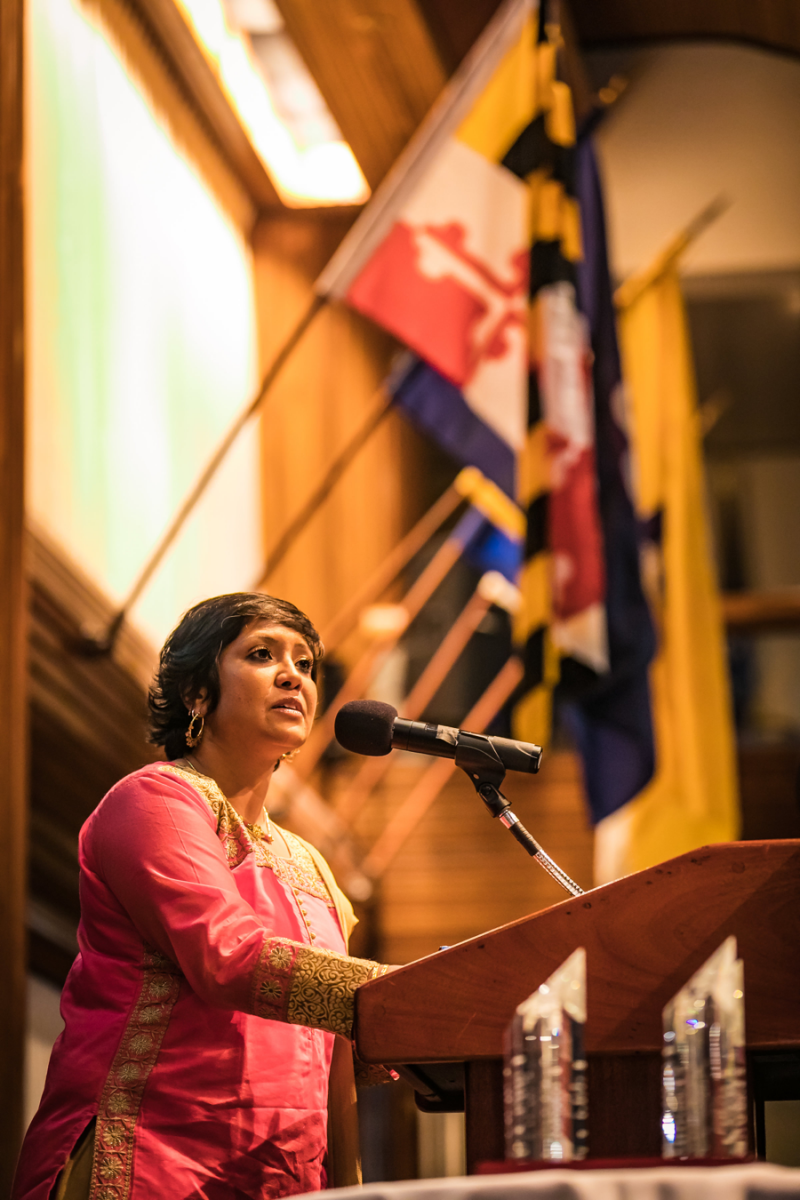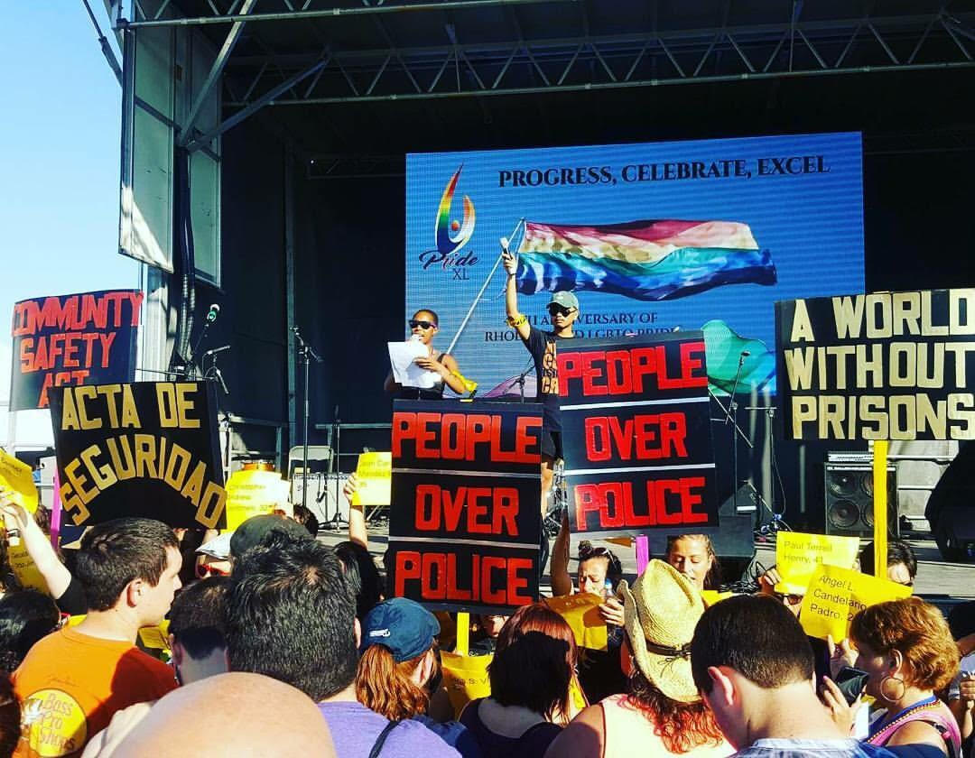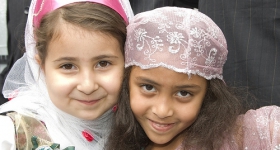On the evening of Wednesday, May 31st, a Pride flag that had been flying outside the home of the mayor of San Luis Obispo, California was set on fire and left on her doorstep.
The next morning, in Washington, D.C., a noose was discovered outside of a home in the predominantly Black neighborhood of Hillcrest — the third noose found in the district that week.
That weekend, a woman wearing a hijab in Columbus, Ohio, was beaten unconscious by a white man who reportedly shouted, “You’ll all be shipped back to Africa.”
The following Monday night, a mosque in Lakewood, Colorado received a threatening call from a man who said, “Allah is a f----ing pig” and “You guys are going to pay for Manchester and London.”
Multiple news outlets reported a dramatic spike in hate crimes across the country in the weeks following the election of Donald Trump. More than half a year later, hate violence continues to plague a wide range of communities, crossing lines of race, religion, gender, sexuality, and country of origin. Amid this violence, Asian American communities — especially Muslim and Sikh Americans from the South and West Asian diasporas — have faced pronounced levels of targeting.
According to a recent report by the Maryland-based national organization South Asian Americans Leading Together (SAALT) , the current spike in anti-Muslim and anti-Asian hate violence mirrors levels in the year following 9/11. In November 2015, SAALT began tracking incidents of hate through a publicly accessible, community-generated online database hosted on its website. In the year leading up to the presidential election, the organization documented 207 incidents of hate violence and xenophobic rhetoric directed at South Asian, Muslim, Sikh, Hindu, Middle Eastern, and Arab Americans.
And reports indicate that these numbers have continued to grow since November.
Suman Raghunathan, Executive Director of SAALT, said the organization has already documented over 100 incidents of anti-South Asian hate violence since the presidential election. “What we’ve seen over the last several years is a troubling tale of a consistent level of violence that seems only to have intensified,” said Raghunathan.
The group’s attempts at getting a clearer picture of anti-South Asian violence come partly in response to the wide gaps in knowledge in official data on hate crimes, such as the Federal Bureau of Investigations’ annual Hate Crime Statistics report. Though the FBI has tracked and reported hate crimes since the signing of the Hate Crime Statistics Act of 1990, the agency had no designations for crimes motivated by anti-Arab, anti-Sikh, or anti-Hindu sentiment until 2015, when intense campaigning led by advocacy groups resulted in their addition.
Further gaps become evident when considering not only the historical underreporting of hate crimes, but also the relatively narrow scope of incidents that meet state or federal statutes to be counted as such. The FBI defines a hate crime as a “criminal offense against a person or property motivated in whole or in part by an offender’s bias against a race, religion, disability, sexual orientation, ethnicity, gender, or gender identity.” Such a definition excludes a wide range of bias-motivated incidents that create unsafe environments for marginalized communities.
“Incidents of harassment of women who are wearing hijabs in their grocery store parking lots, graffiti, verbal assaults on individuals — may not necessarily meet the threshold of being considered a hate crime,” said Raghunathan, but they “nevertheless have a tremendous and demoralizing impact on communities across the board.”
Raghunathan spoke to the importance of allowing communities to track hate violence — a term that encompasses both hate crimes and incidents of intimidation and harassment — on their own terms. “It’s crucial that we do our own due diligence with respect to tracking and documenting incidents of hate violence as they are impacting our communities,” she said.

Suman Raghunathan, Executive Director of South Asian Americans Leading Together (SAALT), one of the national organizations partnering with Community Against Hate. (Credit: Dani Leigh Giannandrea)
Powers Combined
SAALT is one of nineteen national organizations that have recently joined their own efforts to a collaborative initiative dubbed Communities Against Hate, which seeks to address the rise in hate violence through documentation, direct access to legal support through a hotline (1-844-9NO-HATE), and a $3 million fund through the Open Society Foundation for rapid-response grants to local organizations combating hate violence.
Spearheaded by the Leadership Conference Education Fund and the Lawyers’ Committee for Civil Rights Under Law, Communities Against Hate brings together 17 other partner organizations representing a vast range of communities, including Muslim Advocates, Color of Change, the Transgender Law Center, National Council of La Raza, the National Disability Rights Network, and others.
“It’s a diverse coalition of groups coming together for the first time across all of these communities to document hate and demand action while also providing access to support,” said Anjali Thakur-Mittal, Deputy Director for Field Operations at the Leadership Conference and the Director of Communities Against Hate.
At the heart of the initiative is a publicly searchable database of hate incidents. Users can submit incidents directly to the database through the website, or by reporting incidents to partner organizations such as SAALT. Since the initiative launched in March, its database has aggregated over 690 hate incidents, 214 of which are, at the time of this writing, listed as being motivated by anti-Muslim, anti-Sikh, anti-Asian, or anti-Arab sentiment.
“The first step to fighting back against this disturbing trend is to document it,” Thakur-Mittal said.
In a press release for the initiative’s launch, Madihha Ahussain, Staff Attorney at Muslim Advocates, stated: “By collecting critical data and sharing resources with impacted communities, we are striving for a future where Americans of all faiths, races, genders and sexual orientations can live without fear.”
But despite the ways in which South Asian Americans have been targeted by hate violence in the age of Trump, the original list of organizations involved in Communities Against Hate included no groups explicitly representing Asian American communities.
John C. Yang, President and Executive Director of Asian Americans Advancing Justice (AAJC), recalled noticing this gap. “There was Muslim Advocates, representing the Muslim American community, but there was no Asian American voice,” he said, adding, “Asian American voices are often still left out of the equation.”
SAALT was one of many voices to point out, too, that anti-Muslim violence isn’t limited to reaching only Muslim victims and survivors, specifically citing the impact of such incidents on Sikh and Hindu Americans.
“Our communities are viewed as monolithic,” Raghunathan said. “The broad swath of violence affecting our communities for a long time now remains very much equal-opportunity and indiscriminate.”
Since the official launch of Communities Against Hate, a number of Asian American groups, including AAJC, SAALT, and the Sikh Coalition, have joined the efforts. Yang asserted that the current climate of hate violence should raise alarms with all Asian Americans, including groups that may not consider themselves targeted in this moment.
“It’s only a stone’s throw away,” he said, citing recent incendiary political rhetoric around both North Korea and China. “So even for Asian Americans that might consider themselves already very well integrated into American society, I would urge some caution. We all need to be cognizant of this issue.”

Members of PrYSM’s Queer & Trans Thursdays program protest Rhode Island Pride’s collaboration with police at the 2016 Pride Parade. (Courtesy of PrYSM)
Hate and the State
The widening of discourse around who is affected by hate violence, and why, speaks perhaps to the Trump administration’s wide volley of attacks on nearly every sector of society besides white, heterosexual, cisgender men. From the Muslim ban, to the withdrawal of federal protections for transgender students, to the President’s recent claim that immigrant gang members “slice and dice” “young, beautiful girls,” Trump’s presidency has seemed thus far to follow through on the exclusionary rhetoric that marked his campaign.
“Anyone that doesn’t look American, whatever that means, becomes a target,” said Yang.
There are particular challenges that come with combating interpersonal hate violence in the context of a president who retweets a video of himself body-slamming and punching CNN. Amardeep Singh of the Open Society Foundation, which funds the initiative, pointed to the difficulties of doing this work on a national level, especially amidst “a significantly shrinking federal backstop to address hate incidents.”
“The federal agencies that often address incidents of hate or discrimination are facing budget cuts in 2018,” Singh said. “There are mixed signals from the administration as to the seriousness of their enforcement of civil rights law.”
Some of these mixed signals were on display last month, in a summit on hate crimes convened by the U.S. Department of Justice and led by Attorney General Jeff Sessions. Though the Leadership Conference, one of the convening organizations of Communities Against Hate, did attend the summit, they issued a statement expressing frustrations with the administration’s track record on the issue.
In the statement, president and CEO Vanita Gupta, wrote: “This administration — including President Trump and Attorney General Sessions — have used rhetoric and promoted policies that have sown greater fear among vulnerable communities that are too often victims of hate.”
Multiple groups also criticized the administration for folding its investigations of hate crimes into the Justice Department’s Task Force on Crime Reduction and Public Safety, a subcommittee set up to investigate violent crimes committed by undocumented immigrants, despite overwhelming evidence that immigrants are less likely to commit crimes than people born in the United States.
Raghunathan of SAALT (which chose not to attend the summit) remarked that the implication that hate violence needs to be considered by this same subcommittee “sends a very troubling and conflicting message to our communities.”
Overall, the role that law enforcement agencies — federal, state, and local — can or should play in combating hate violence has been a point of debate among the various players involved.
The Rocky Mountain Islamic Center in Lakewood, Colorado, for example, reportedly asked for an increase in police presence after receiving threatening those phone calls, a request with which local police complied.
Meanwhile, Raghunathan pointed to the ways in which a history of racial profiling and surveillance practices — including, notably, surveillance of mosques — has eroded trust between some Asian American communities and law enforcement.
“Many South Asian American communities understand the risks associated with coming forward to report an incident of hate violence to the FBI,” she said, citing what she referred to as “the wide arm of problematic policies on the part of some law enforcement agencies.”
In fact, some activists and advocates have argued that relying on the criminal justice system to address hate violence helps only to tilt power away from communities and toward existing apparatuses of state violence. In a 2015 article in the Asian American Law Journal, for example, authors Pooja Gehi and Soniya Munshi write: “For communities of color and LGBTQ (lesbian, gay, bisexual, trans, and queer) communities who are already at risk for institutional violence, solutions that are built on a foundation of criminalization become a source of violence as they intensify policing mechanisms.”
On the other hand, Yang stated that, while his organization recognizes the harms of police brutality and discriminatory policing practices, AAJC fundamentally believes that “police have to be part of the solution.”
“The vast majority of police officers and law-enforcement officials are well-meaning people,” Yang said. “So how do we work with them to provide the proper training, to provide the proper support so that they can do their job well?”
This view seemed to be supported by a spokesperson for the Open Society Foundation, which, as part of the Communities Against Hate initiative, granted the Providence Police Department in Rhode Island $114,300 over one year for “cultural competency and de-escalation training.”
“The grant makers were aware that relations between the Providence Police Department and the community have been tense, and that hate crimes have been underreported as a consequence,” the spokesperson said, adding that the intent of the local grants was “to come at hate from all angles.” The grant was the only one awarded to a municipal police department through this funding stream, according to the foundation’s website.
Shannah Kurland of the Providence Youth Student Movement (PrYSM), a Southeast Asian youth-led organization fighting the criminalization of communities of color, expressed frustration at hearing that the initiative had funded the same police department that has been the target of multiple PrYSM campaigns around abusive police practices.
“You’re giving more resources to the people who are beating up our families, our neighbors,” Kurland said. “That money just makes them slicker and more effective at oppressing our community.”
PrYSM was recently also granted $70,000 through the same funding stream to build a multi-racial rapid-response network to address instances of “state-sponsored and individual acts of hate” — including police brutality. Despite this support, Kurland, who was also the recipient of a Soros Fellowship through Open Society Foundation, vehemently disagreed with the foundation’s decision to fund both sides. “If they’re going to fund the Providence Police Department, then they need to call it Communities for Hate,” she said.
As to Communities Against Hate’s stance on the role of law enforcement in its vision, the initiative’s director, Thakur-Mittal responded, “That is a conversation that is ongoing.”
Singh recalled that some of the partner organizations of Communities Against Hate had, in early conversations, recognized the limits of a over-reliance on incarceration to combat a climate of hate not wholly separable from state violence. As a result, the coalition agreed to add a commitment to restorative justice to the Statement of Principles listed on the initiative’s website.
Singh offered a reminder that the initiative as a whole is “an experiment — which is still in development — about whether groups across communities can collect this information together, and what happens when they do.”
Indeed, many of the representatives from the various organizations involved used the term “unprecedented” when speaking in reference to diversity of the coalition — not only in the communities represented, but also in scope, strategic approach, and political alignment on many aspects of the work, including perspectives around incarceration and police.
Despite these differences and the disturbing trends documented in regards to hate violence, Raghunathan said she’s “actually quite optimistic about the path forward.” She said that groups like SAALT are witnessing not only “a tremendous level of community engagement around issues of racial profiling and community policing” but also a new generation of South Asian Americans being politicized and mobilized to act. “I’ve been really encouraged at the groundswell of engagement,” Raghunathan said.
Though the challenges of combating violence in this particular political moment may be distinct, these questions — how to understand the relationship between individual and state violence, how to build solidarity among groups with contrasting visions for solutions — are as old as the movements that grapple with them.
Current conversations recall, for example, a 2001 statement by INCITE!, a national organization of women, gender non-conforming, and transgender people of color against violence, titled “Gender violence and the prison industrial complex.” In the statement, INCITE! calls on social justice movements “to develop strategies and analysis that address both state AND interpersonal violence.”
But what may speak most clearly to the questions at hand is the group’s statement regarding the wedges driven between communities combating hate. Interrogating the reliance on state funding to support anti-violence programs, INCITE! writes: “Such reliance has isolated the anti-violence movement from other social justice movements that seek to eradicate state violence, such that it acts in conflict rather than in collaboration with these movements.”
“This is a powerful solidarity-building moment,” Raghunathan said. If nothing else, perhaps the current foregrounding of the range of communities affected by violence — whether directly perpetuated by the state or merely emboldened by it — demonstrates exactly how urgent the taking-up of that moment is.










Comments